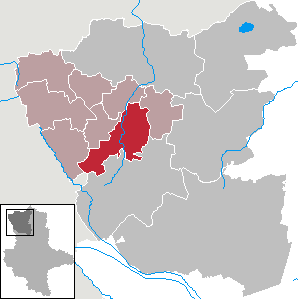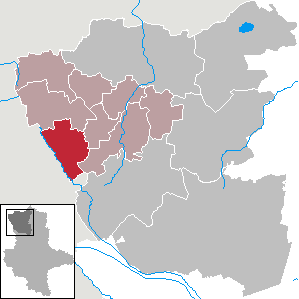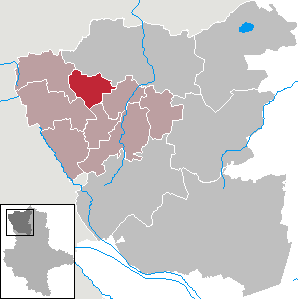
Salzwedel is a town in Saxony-Anhalt, Germany. It is the capital of the district (Kreis) of Altmarkkreis Salzwedel, and has a population of approximately 21,500. Salzwedel is located on the German Timber-Frame Road.

Altmarkkreis Salzwedel is a district in Saxony-Anhalt, Germany. It is bounded by the districts Gifhorn, Uelzen, Lüchow-Dannenberg in Lower Saxony, and the districts of Stendal and Börde (district).
Stendal is a district in the north-east of Saxony-Anhalt, Germany. Its neighbouring districts are : Jerichower Land, Börde, Altmarkkreis Salzwedel, Lüchow-Dannenberg in Lower Saxony, and the districts of Prignitz, Ostprignitz-Ruppin and Havelland in Brandenburg.

Arendsee is a town in the Altmarkkreis Salzwedel, Saxony-Anhalt, Germany. It is named after the lake Arendsee, located north of the town.

Klötze is a town in the Altmarkkreis Salzwedel (district), in Saxony-Anhalt, Germany. It is situated approximately 20 km northwest of Gardelegen, and 35 km northeast of Wolfsburg. It was mentioned first in 1144 with the name Cloetze, which means a wooden block. In January 2010, with the disbanding of the Verwaltungsgemeinschaft of Klötze, the town absorbed 11 former municipalities.

Flechtingen is a municipality in the Börde district in Saxony-Anhalt, Germany. It is situated approximately 35 km northwest of Magdeburg. On 1 January 2010 it absorbed the former municipalities Behnsdorf, Belsdorf and Böddensell.

Niedere Börde is a municipality in the Börde district in Saxony-Anhalt, Germany. It is situated between Haldensleben and Magdeburg. It was formed in January 2004 by the merger of the former municipalities Dahlenwarsleben, Groß Ammensleben, Gutenswegen, Jersleben, Klein Ammensleben, Meseberg, Samswegen and Vahldorf.

Seehausen is a town in the district of Stendal, in Saxony-Anhalt, Germany. It is situated approximately 30 km (19 mi) north of Stendal in the Altmark, a historic region in Germany, comprising the northern third of Saxony-Anhalt. In January 2010 it absorbed the former municipalities Beuster, Geestgottberg and Losenrade, and in September 2010 Schönberg.

Tangerhütte is a town in the district of Stendal, in Saxony-Anhalt, Germany. It has a population of 10,612 (2020) and is situated on the river Tanger, approximately 20 km south of Stendal.

Calvörde is a municipality in the Börde district of Saxony-Anhalt, Germany. It is part of the Verbandsgemeinde Flechtingen.

Schönhausen is a municipality in the district of Stendal in Saxony-Anhalt in Germany. It is the seat of the Verbandsgemeinde Elbe-Havel-Land.
Börde is a district in Saxony-Anhalt in Germany. Its seat is the town Haldensleben. It takes its name from the natural region Magdeburg Börde. It is the site of the Morsleben radioactive waste repository. The disposal of waste into the facility ended in 1998.

Rohrberg is a municipality in the district Altmarkkreis Salzwedel, in Saxony-Anhalt, Germany. Since January 2009, it includes the former municipalities of Ahlum and Bierstedt.

Beetzendorf is a municipality in the district Altmarkkreis Salzwedel, in Saxony-Anhalt, Germany. It consists of the following Ortsteile or municipal divisions:

Dähre is a municipality in the district Altmarkkreis Salzwedel, in Saxony-Anhalt, Germany. A section of the Salzwedeler Dumme river flows through it. Since 2009 it has incorporated the former municipalities of Bonese and Lagendorf.

Jübar is a municipality in the district Altmarkkreis Salzwedel, in Saxony-Anhalt, Germany. Since 1 January 2010 it has incorporated the former municipalities of Bornsen, Hanum, Lüdelsen and Nettgau.

Kuhfelde is a municipality in the district Altmarkkreis Salzwedel, in Saxony-Anhalt, Germany. Since 2009 it has included the former municipalities of Püggen, Siedenlangenbeck and Valfitz.

Wallstawe is a municipality in the district Altmarkkreis Salzwedel, in Saxony-Anhalt, Germany. Since July 2009 it has included the former municipalities of Ellenberg and Gieseritz.

Am Großen Bruch is a municipality in the Börde district in Saxony-Anhalt, Germany. It is part of the Verbandsgemeinde Westliche Börde. The municipality was created on 1 July 2004 by the merger of the former municipalities Gunsleben, Hamersleben and Neuwegersleben. On 1 January 2010 it absorbed the former municipality Wulferstedt.

Apenburg-Winterfeld is a municipality in the district Altmarkkreis Salzwedel, in Saxony-Anhalt, Germany. It was formed by the merger of the previously independent municipalities Apenburg, Winterfeld and Altensalzwedel, on 1 July 2009.
























